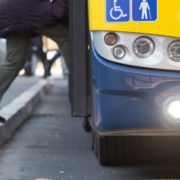Strategies for Keeping Your Bus Passengers Safe: Reducing Accidents and Improving Service
In the transportation industry, protecting passengers has to be a high priority. For example, within the bus industry, it is critical to take every step possible to minimize falls and other accidents that increase liability insurance costs and drive passengers away to other services. In an industry that needs to increase passengers, working from a safety standpoint is an excellent place to start.
The Benefits of Improving Safety on Bus Transportation
The U.S. Department of Transportation reports that 10.2 billion people used public transportation of some type in 2016. That amount has grown by as much as 20 percent in the last two decades. And, with a stronger push towards reducing emissions and fewer people wanting to purchase cars themselves, bus transportation is on the way up.
By taking steps to improve the safety on your bus, you’re able to encourage increased ridership. Benefits of boosting safety include:
#1: Reducing Insurance Premiums
When fewer passengers fall and suffering injuries, there are fewer insurance claims to file. This is a fast and simple way of reducing costs.
#2: Improving Customer Service
With improved safety, consumers view bus transportation in a positive light. More so, they enjoy the atmosphere. Stepping onto a bus that’s well lit, pleasant, and easy to relax on, ensures a better experience every time.
#3: Serve More Consumers
It’s nearly always more cost-effective for a consumer to use bus transportation than to drive to and from locations such as work and school. Yet, perceives unsafe conditions often limit their willingness to do so. By improving conditions, it’s possible to boost ridership through better service.
The benefits are clear. And, in some situations, improving safety can also mean better revenue for companies. How do you do it?
How to Increase Bus Passenger Safety – Simple Steps to Make Significant Improvements
There are various ways to improve safety on buses. No one solution is best. Rather, an overall focus should be employed whenever possible.
#1: ADA Compliance Is a Must
Americans with Disabilities Act requirements are nothing to overlook when designing and improving bus transportation. The Federal Motor Carrier Safety Administration spells out what these requirements are, including providing access. In many situations, a person with disabilities, such as someone requiring a wheelchair, needs to be able to have access to a bus route. Don’t overlook others, too. For example, accessible buses can include those that offer more handrails and more comfortable seating.
#2: Improve Interior Bus Lighting
Lighting is by far the most important investment for any bus safety improvement process. Consider simple and effective lighting solutions. This includes above head lighting, floor lighting to minimize tripping, and lights near seats to improve visibility.
#3: Improve Exterior Bus Lighting
Exterior lighting must meet SAE/DOT requirements. Never add any product to a bus that lacks the proper approval of DOT. However, there are many ways to add exterior lighting to minimize risks, especially to ensure other drivers don’t miss the loading of passengers. Bright light bars, for example, can enhance visibility significantly and inexpensively. Install rear lighting to minimize the risk of rear-end accidents.
#4: Provide Warning Signs on the Bus
Simple warning signs can be an important tool for most buses, but they can work to enhance safety easily. For example, place warning signs near steps to ensure there is no question that a step is present. If the bus entails an area where the doors swing and a person’s hand can get caught, place a warning sign. This helps minimize liability risks as well.
#5: Provide Clear Information on Routes and Locations
Educate riders about locations and routes. Ensure all routes are marked and understood not just prior to boarding, but also on the bus. The goal here is to ensure each person knows what to expect along the trip. Then, include wireless bell push features that allow passengers to communicate about their needs.
There are legal requirements for all lighting needs on public transportation. ADA requirements are also important. Yet, it is also financially wise to invest in any and all of these upgrades to bus safety to ensure each person is able to ride the bus safely and without any risk of injury. This reduces costs and enhances the customer experience.




